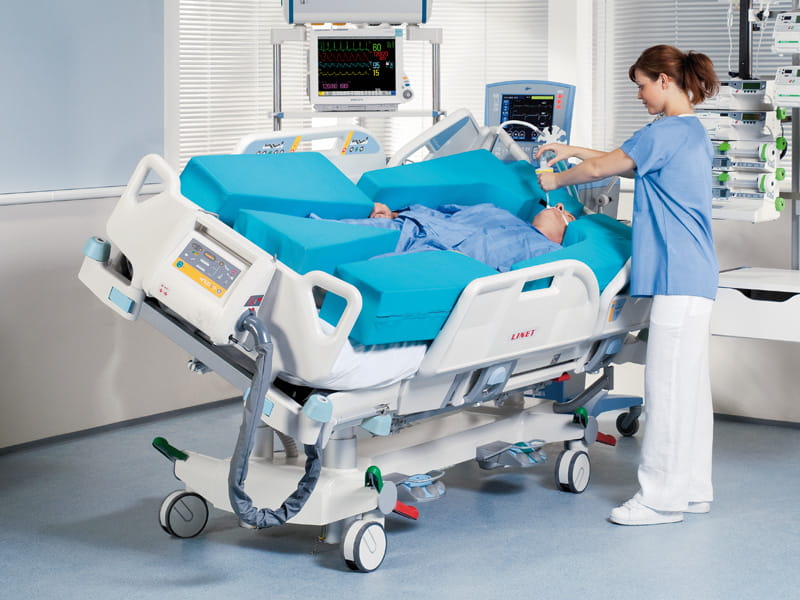Automatic lateral therapy in the prevention of pulmonary complications
Pulmonary complications (such as ARDS, VAP and bronchopneumonia) are a common phenomenon in intensive care with a high mortality rate. Their fundamental treatment involves the improvement of oxygenation by ventilator and other supportive methods – the prone position also plays a significant role. The Multicare bed is designed for critical and intensive care and is therefore also equipped with a unique Automatic Lateral Therapy (ALT). ALT allows for the continuous tilting of the patient to the required angles. Tilt angles and timing are individually adjustable with respect to the patient’s needs and degree of tolerance.

Prevention of pulmonary complications
Positioning with ALT is also a part of modern VAP prevention strategies. It can help to improve oxygenation, gas exchange in the lungs and can enhance the suction of fluids from the lungs.
It helps to reduce the rate of atelectasis and the relative risk of VAP. The gross mortality rate of VAP ranges from 24-50%, with VAPs caused by nosocomial pathogens amounting to up to 76% 1.
Prone position
The prone position improves oxygenation, helps to pass through the atelectatic parts of the lungs and improves gas redistribution in the lungs. Gravity and application of inspiratory pressure are used in the prone position, which results in better chest openness and a higher compliance of the pleura2.
Up to 70% of patients in the prone position showed a beneficial reaction after just 1 hour of positioning3.
The lateral tilt of the Multicare bed together with the Prone version of the Virtuoso mattress helps to achieve the prone position in an efficient way with reduced physical effort by the ICU and a lower risk to the patient.
How does ALT work?
The user-friendly interface of the Multicare bed allows for the ALT to be programmed easily with respect to the patient’s current needs. The bedframe tilts to the required angles at the time interval adjusted by the ICU staff. The patient is stabilised in the bed centres by means of the accessory pads to prevent the risk of fall or unintentional extubation.
References:
1. Guerin C, Reignier J, Richard JC, Beuret P, Gacouin A, Boulain T, Mercier E, Badet M, Mercat A, Baudin O, Clavel M, Chatellier D, Jaber S, Rosselli S, Mancebo J, Sirodot M, Hilbert G, Bengler C, Richecoeur J, Gainnier M, Bayle F, Bourdin G, Leray V, Girard R, Baboi L, Ayzac L, PROSEVA Study Group: Prone positioning in severe acute respiratory distress syndrome. N Engl J Med 2013, 368:2159–2168
2. Fridrich P, Krafft P, Hochleuthner H, Mauritz W. The effects of long-term prone positioning in patients with trauma-induced adult respiratory distress syndrome. 1996.
Online: https://www.ncbi.nlm.nih.gov/pubmed/8942587
3. Eimerová L. Pronační poloha v UPV akutního respiračního selhání a syndromu akutní dechové tísně. 2006.
Online: http://zdravi.euro.cz/clanek/sestra/pronacni-poloha-v-upv-akutniho-respiracniho-selhani-a-syndromu-a-278900




